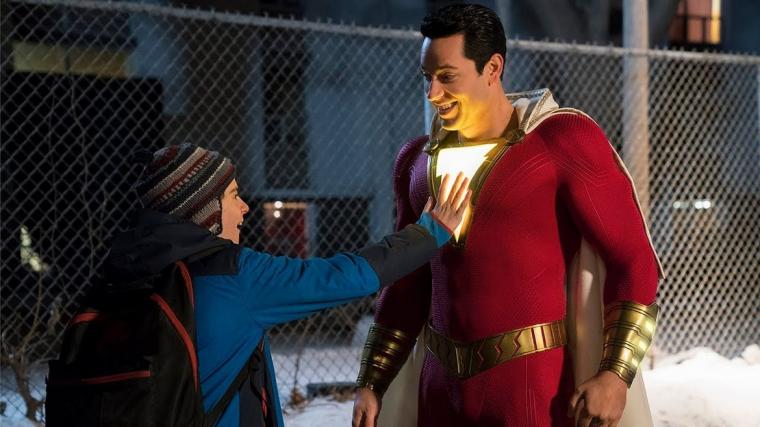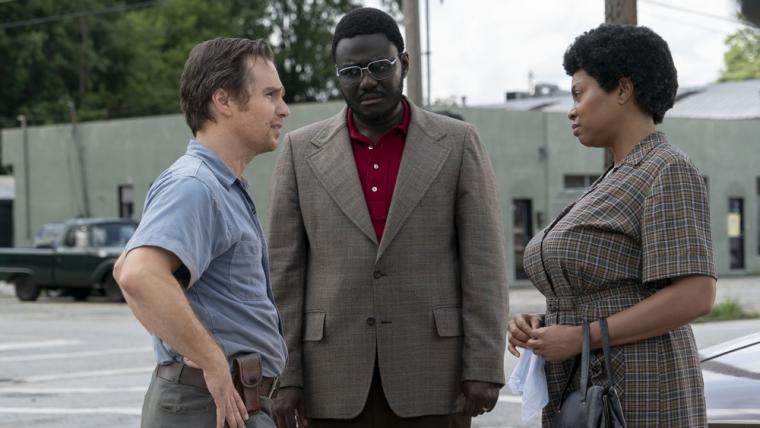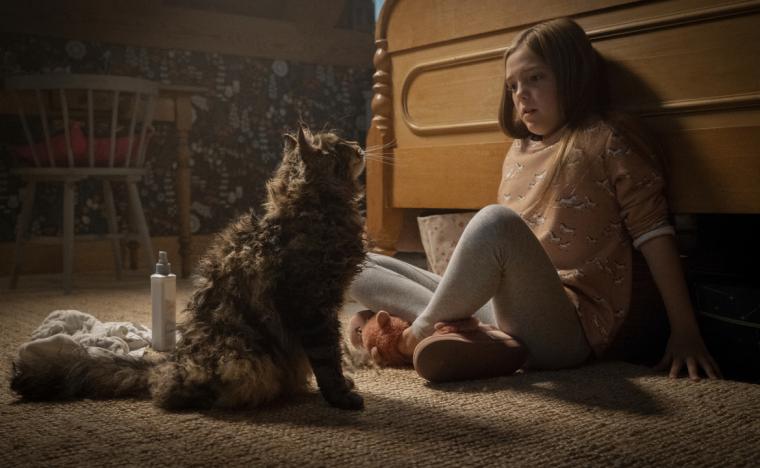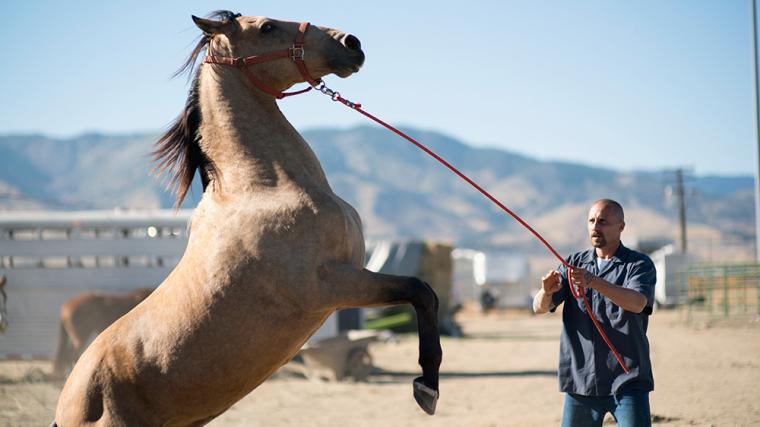
Friday, April 5, 9:50 a.m.-ish: As today's quadruple feature, unlike last week's, is entirely free of live-action Disney remakes and 95 minutes trapped on a beach with Matthew McConaughey, I'm already anticipating a better overall time during these particular eight-plus hours at the cineplex. But even though its previews were enjoyably cheeky, I still wind up flabbergasted by just how much fun I have at Shazam!, the latest superhero epic that (with apologies to the first three-fourths of Wonder Woman) is hands down the finest yet from DC Studios. Those trailers suggested Big in shiny red Spandex, and the trailers didn't lie. Director David F. Sandberg's comic-book outing, however, isn't reminiscent of the Tom Hanks comedy merely because it's about a young teen magically transformed into an adult. It's also fast and funny and clever and touching in the manner of Big – so much so that all that's really missing is the sight of Robert Loggia on a giant walking piano. And the giant walking piano actually makes an appearance.
Admittedly, it takes a while for things to get rolling. Before 14-year-old foster kid Billy Batson (Asher Angel) has his fateful encounter that turns him into the costumed crime fighter of the title, there's a needlessly dour, poorly acted prelude that serves as the chief villain's origin story, complete with a tacky subterranean lair and Djimon Hounsou, as an elder wizard, delivering heavy-handed exposition. That's followed, in short order, by lame slapstick involving a pair of bumbling cops, a maudlin flashback explaining the absence of Billy's mother, and aggressively adorable time spent in Billy's new foster home where the caregivers (Cooper Andrews and Marta Milans) are unfailingly kind and their other racially, ethnically, and gender-mixed charges – all five of them – seem to have wandered in from the rejected pilot for a Disney Channel sitcom. While Angel has obvious talent and presence, you may find yourself, during the movie's first half hour, uncomfortably antsy for that boring wizard's return, when Billy's declaration of “Shazam!” will replace his youthful frame with the cartoonishly muscular physique of Zachary Levi. Thankfully, though, when the moment comes, it proves worth the wait – as do the 100-ish minutes that follow, which deliver roughly the same number of laughs as a Deadpool flick, but with unapologetically friendly, gee-whiz enthusiasm replacing the snark.
This being a planned franchise-starter that exists in the same universe as DC's grim-and-bear-it takes on Batman and the Man of Steel, I anticipated that the high comedy of Billy's Shazam discovering his superpowers and causing Big-ish mischief would lead to a typically endless climactic fight, this one involving a nefarious Mark Strong and his posse of goblin-ized Seven Deadly Sins. That's exactly what occurs. What I didn't anticipate, however, was that the finale's battle royale would prove witty, surprising, and cackle-inducing, with even our hero's native city of Philadelphia a fully flesh-out comic figure, and Henry Gayden's screenplay producing verbal and visual gags to spare. (One of them, in which the floating villain whispers dastardly threats to the similarly airborne Shazam, is a joke that's been dying to be made for decades.) And the instant that Levi, in a fresh and inspired performance, blasts into view, just about everything in Sandberg's comic-book flick works: the sharp, playful banter between Shazam and Billy's new foster brother Freddy, whom the excellent Jack Dylan Grazer plays with motor-mouthed spirit to equal his hypochondriac Eddie in It; the brutal attacks of those goblins, especially after they interrupt a high-rise board meeting; the unexpectedly moving, resonant family dynamic created by Billy's foster family. Even the resolution to that missing-mom subplot is effective, demonstrating that there actually are a few human beings worse than an incensed Mark Strong. All told, though, Shazam! is a wonder because it's so wonderfully buoyant – a blessedly featherweight entry in a genre too frequently prone to self-seriousness. In his spandex and cape, Billy employs his newfound gifts and adult visage for selfies and YouTube fame and the purchase of beer (which he promptly spits out), and every minute of this nontraditional hero's journey is a joy. At one point, perhaps inevitably, one of Shazam's superpower montages is underscored to Queen's “Don't Stop Me Now,” and it's inconceivable that anyone watching would ever want him stopped.

12:15 p.m.-ish: Ordinarily, you can count on films at the Davenport cineplex to begin around 20 minutes after their scheduled start times, given our apparent need for six or seven trailers and that long-running Coca-Cola ad that opens with a ride up an escalator and the query “So-o-o-o … you hear anything about this movie?” (Like many of you, I'm sure, I have that whole 30-second script now committed to memory, and currently entertain myself before screenings by silently mouthing it á la TV's Lip Sync Battle.) Yet for some odd reason, when I walk into my 12:15 showing of The Best of Enemies at 12:20, the race-relations drama has already started, and we already appear so firmly entrenched in plot that I check my ticket stub, twice, to make sure I'm in the right auditorium. I am, but consequently don't know whether writer/director Robin Bissell's feature debut actually starts with the scene I walk in on – Sam Rockwell's KKK leader C.P. Ellis making plans to shoot up a southern woman's home – or rather with some prelude that introduces Rockwell's protagonist as, you know, not the worst person on Earth. In the end, though, I suppose it doesn't matter. The Best of Enemies goes so overboard in its quest to cast Ellis as a fundamentally decent chap who just happens to be the Exalted Cyclops of the Ku Klux Klan that the film would no doubt seem misguided, occasionally lapsing into astoundingly tone-deaf, regardless of its intro.
Look: I'm all for rehabilitation, and there is indeed inspiration to be found in the movie's telling of how Ellis and civil-rights activist Ann Atwater (played here by Taraji P. Henson) called an end to their mutual loathing while debating school-integration practices in 1971 North Carolina. In real life, Ellis ceased his association with the Klan, he and Atwater became lifelong (if tetchy) friends, and Atwater gave the eulogy at Ellis' 2005 funeral. Those facts are touching and admirable. And Bissell's film might have been, too, if it played fair by its subjects, giving Atwater equal screen time and making the plight of oppressed southern blacks at least as narratively important as Ellis' fears about appearing weak in front of his KKK pals. But despite receiving top billing, the lion's share of presence on the poster, and enough I'm-proud-and-I'm-pissed outbursts to fill a decade's worth of Oscar clips, Henson still manages to feel like an afterthought, with Bissell showing almost zero interest in Ann Atwater, her family, and her long-standing reputation as an instrument for social change. By contrast, the film's nearly sole focus is on Ellis, and while Bissell's movie has clearly been designed as his redemption story, it shaves down the inherent ugliness of the man's character to such a degree that, barring his frequent use of a certain racial epithet, this Klansman doesn't appear hateful so much as blithely unaware in the manner of Viggo Mortensen's lovable bigot in Green Book. (At its heart, The Best of Enemies is a Green Book for people who would've appreciated our reigning Best Picture winner more if it weren't quite so funny.)
Tellingly, we never once catch Rockwell's Ellis wearing a hood – unless, again, it happened prior to my 12:20 arrival – and the only violence we see him perpetrate is against the property of a white woman, which feels as calculated it does convenient. Here's what we do see: Ellis being unfailingly affectionate with his wife (an underused Anne Heche). Ellis being unfailingly sweet to his hospitalized son with Down's Syndrome. Ellis paying respect to a Vietnam veteran (John Gallagher Jr.) whom he realizes he misunderstood. Ellis being receptive to Atwater's expressions of kindness. Ellis slowly but surely recognizing the error of his ways. Ellis bristling at loathsome Klan activities he formerly championed. Ellis giving the big, climactic, grossly fraudulent speech that leads to applause from its mixed-race audience. With the supporting cast boasting Babou Ceesay, Wes Bentley, and the great Bruce McGill, this inarguably well-meaning drama is acted with skill, and I appreciate that the film introduced me to the concept of the charrette, in which matters such as this movie's school-integration debate are discussed in a deadline-oriented, group-conversation format. A Best of Enemies with that civic-minded process at its center would've truly been something to witness. Unfortunately, we're left instead to witness yet another dubious, formulaic Hollywood offering that doesn't know how to tell its race-relations story except through the perspective of an unenlightened middle-aged white man. Here's praying the 2020 Best Picture Oscar isn't already all sewn up.

2:25-ish: Offhand, I can think of no Stephen King property more deserving of a remake than Pet Sematary, the 1989 horror flick based on the author's phenomenally creepy, über-disturbing 1983 novel. When 15-year-old me first read the book upon its initial publication, I presumed, mistakenly, that it was too upsetting to ever film ... and possibly impossible, to boot, given the acting challenge that would've been placed on the shoulders of a two-year-old boy. Director Mary Lambert gave it a shot anyway, and despite an enjoyably game portrayal by toddler Miko Hughes and a pretty terrific performance by Fred “Herman Munster” Gwynne, what resulted was one of the all-time worst King adaptations – profoundly silly when it was meant to be scary, and so divorced from human (and animal) experience that nothing seemed to be at stake when the dead made their inevitable transitions into undead. A remake could only be an upgrade, and the new Pet Sematary by directing partners Kevin Kölsch and Dennis Widmyer is indeed less atrocious than its 30-year-old precursor. If only that were anything resembling a compliment.
Stephen King, of course, is a master storyteller. But as evidenced by his prose and occasional forays into screenwriting (including 1989's Pet Sematary), he's rarely been adept at writing believable or even borderline-interesting things for his characters to say. Kölsch's and Widmyer's outing, meanwhile, finds screenwriter Jeff Buhler mimicking King's dialogue with unfortunate precision. While the film weaves its tale of a Boston family who takes residence in rural Maine and assumes accidental ownership of the ickiest of final resting places, there isn't a single sentence that feels unforced or in any way recognizably real. As they generally do in King's novels, people here talk at each other rather than to each other, blending their bland exposition with portentous, poster-ready utterances of the “Sometimes dead is better” variety, and the film is criminally bereft even of King's traditional cornball jokes. (The only genuine laugh comes when our doctor protagonist misdiagnoses an animal as deceased, and his wife correctly states, “Good thing you're not a f---ing vet.”) Yet you can forgive a horror movie for crummy dialogue – for anything, really – if it's scary enough. And not only isn't Pet Sematary scary enough; it isn't scary, period.
Granted, I jumped in my seat whenever one of the film's ominous semi trucks blasted its horn while hurtling past – just like I do in real life whenever the same thing happens on the highway. But those are the easiest kinds of cinematic jolts, and where Kölsch's and Widmyer's release truly fails is in the trickier, more sustained kind – the bone-deep dread of what's to come that King's novel had in spades and that neither of its adaptations comes close to replicating. Fans of the book will likely appreciate the movie's fidelity to many of King's more outré diversions, one of which, involving an ill-functioning dumb waiter, comes with a miniature nod to Kubrick's bleeding elevator in The Shining. Yet while I won't give away the reveal, I will say that the movie's trailer ruins one of the biggest narrative switches from page to screen, and I found it a thunderously bad decision that undermines the novel's most disturbing implications and turns unimaginable horror into standard devil-child thrills of the type we just experienced in February's The Prodigy. The performances, too, are underwhelming, and although the directors elicit fine reaction shots from twins Hugo and Lucas Lavoie and a fantastically unkempt kitty, Jason Clarke (seemingly unable to fully shake his Chappaquiddick accent), Amy Siemetz, Jeté Laurence, and John Lithgow wind up as dimensionless as their purely functional dialogue. From the meant-to-be-chilling cemetery that resembles discarded Into the Woods set pieces to the thudding obviousness of the “shocking” attacks, the movie is just a disappointing bummer. Maybe, in another 30 years, some enterprising filmmaker will have finally cracked the Pet Sematary-adaptation conundrum. I think it's equally possible, though, that it just won't happen. Sometimes read is better.

4:40-ish: Quadruple-feature day ends with director Laure de Clermont-Tonnere's Western/prison-flick hybrid The Mustang, the tale of a violent convict who enters a rehabilitation-therapy program in which wild horses on the Nevada plains are trained to be more docile, with those training them becoming more docile in return. In its art-house way, the movie is every bit as obvious and predictable as something like The Best of Enemies, with the metaphors instantly graspable and the people on-screen not so much specific individuals as immediately recognizable archetypes: the brooding, volatile inmate revealed to be less bloodthirsty than emotionally damaged; the wisecracking sidekick who suffers a tragedy so our hero can learn a lesson; the weathered, grizzled old coot whose profane talk hides a secret sensitive side. (That the coot in question is played, terrifically, by Bruce Dern might be all that needs to be said about the character.) Yet this simple, touching work, with its blend of wide-reaching vistas and suffocatingly dank prison cells, is most certainly beautifully shot by cinematographer Ruben Impens. And as sensational as de Clermont-Tonnere's movie looks, it might be even more fun, on repeat viewings, merely to listen to, just to see if you can tell the difference between the heavy snorts and wheezes of its titular steed and the heavy snorts and wheezes of star Matthias Schoenaerts.
It hardly takes a master's degree in equine symbolism ('cause that's a thing) to correctly deduce that the actor's brutal offender Roman Coleman and the wild horse he comes to name Marquis – whom he incorrectly pronounces as “Marcus” – are mammals cut from the same cloth, both desperately in need of affection yet initially unwilling to be tamed. Their first scene together, in fact, comes perilously close to a standard Hollywood Meet Cute, with the caged animal furiously banging against his cage and Roman the only person seemingly able to hear and help the beast. But that doesn't dilute the pleasure of Schoenaerts' intensely physical and largely non-verbal performance. An ideal romantic lead in Far from the Madding Crowd who was also the only human being in sight in 2015's The Danish Girl, the Flemish performer is believably American here (certainly more so than the Australian Jason Clarke in Pet Sematary), and just as believably feral, his guttural explosions of breath and rage as seemingly natural as his mustang's. Yet Schoenaerts also hypnotizes you with his airs of beaten-down melancholy and interior pain, and on the rare occasions he's allowed to verbalize Roman's suffering, the man is exquisite; the scene in which the convict finally reveals the reason for his prison sentence, quietly spoken to a heartbreaking Gideon Adlon as Roman's daughter, is screen acting at its most affecting and intimate.
An unnecessary and, frankly, kind of ridiculous drug-smuggling subplot somewhat mars the experience, as does the surprise information that the fate of the entire rehabilitation program rests with how well Roman and Marquis handle themselves at the prison's annual wild-steed auction. (While most of de Clermont-Tonnere's film held me in rapt silence, this reveal did cause me to mutter an audible “Huh?!”) Yet The Mustang still boasts much of primal power that fueled last year's magnificent, similarly themed The Rider. And with strong turns also delivered by Jason Mitchell and Connie Britton, the film is absolutely worth seeing for its two splendidly charismatic leads – one of them a figure of unbridled impulse finally understanding what true freedom is, and the other unexpectedly comfortable with a saddle on his back.
6:30-ish: I exit the cineplex thinking seriously about going home and starting another read of Pet Sematary. Instead, I have dinner, check e-mails, hit the couch, and crash early during my umpteenth re-watchings of favorite West Wing episodes. Sometimes, dead(-tired) is better.










